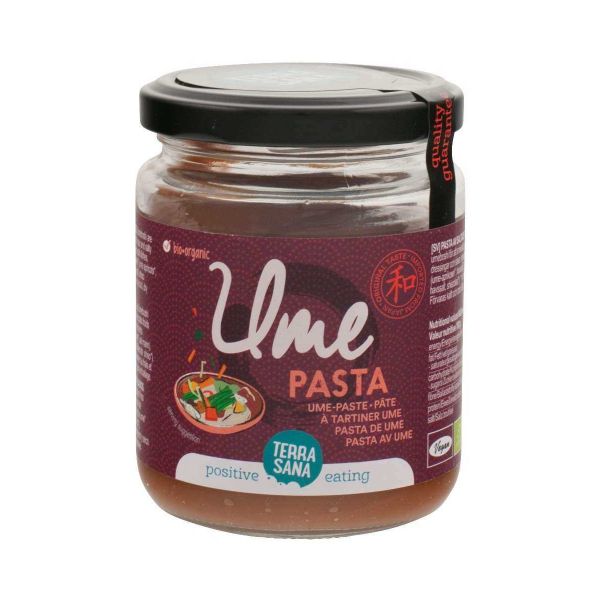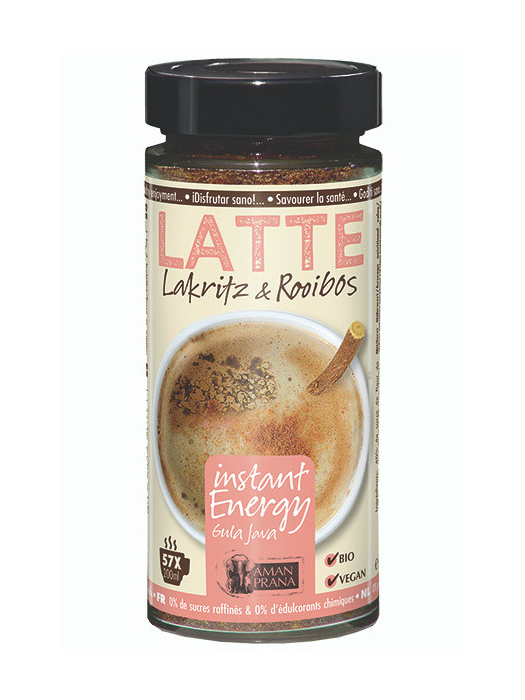Umeboshi paste – glass jar, 250 g
TerraSana
✔ Ume fruit fermented with shiso and sea salt
✔ Authentic flavour of Japanese cuisine
✔ Strong salty and acidic flavour
✔ 100% organic, sold in a glass jar
- Buy per box of 6 for € 11,81 each and save 2%
TerraSana Ume paste: puréed umeboshi with shiso and sea salt
Ume is a Japanese superfruit with a strong, salty, acidic flavour. A unique eating experience! Ume paste is made from fermented ume fruit, ume vinegar (the liquid from the pickled ume fruit) and pickled shiso leaves. In Japan, ume paste is often served as an accompaniment to a dish. You can also use it to add flavour to rice, use it in a dressing or sauce, or dip sushi in it.
The protein, mineral and fat content is twice as high as in other fruit. In Japan, ume is known as ‘the blue diamond’. For more than a thousand years, Japanese people have been using umeboshi as a health tonic, preservative and antibacterial agent, and as an energy drink for samurai. Here we would call the extraordinary ume an apricot or a plum, but a Japanese person would invariably say: “It’s not a plum or an apricot – it’s an ume.” According to an old Japanese proverb: “Drink umeboshi in the morning and you’ll be protected from evil spirits for the entire day.”
From ume to umeboshi to umeboshi paste
You can’t eat fresh ume, which is why in Japan they salt it, dry it and ferment it first. It’s a long process. Ume fruits are harvested in late June, cleaned, and placed in huge vats between layers of sea salt. The salt draws the juice out of the ume and produces brine in the tubs, where the ume ferments for about two months. The juice is set aside and used to make ume su (a sharp-tasting ume sauce or seasoning). The ume fruits are then placed one by one on racks and left outside in the sun to dry, which takes three to five days depending on the weather. This is where the ‘umeboshi’ is born: it literally means ‘dried ume’. Next, the umeboshi matures in barrels for several months, and sometimes up to a year. The deep red colour appears when the matured umeboshi is put back in the brine, alternating with layers of shiso leaves. It is then left for two months until the colour changes from a sun-dried earthy colour to pinkish-red.
Recipe with ume

Beetroot and onion with an ume vinegar dressing
Once you’ve roasted the beetroot, this earthy, punchy salad is quick to make..
Ingredients
4 small beetroot
1 small red onion
1 tsp fresh lemon juice
1 tsp sesame seeds, preferably unhulled
1 tbsp extra virgin olive oil
2 tbsp ume paste (umeboshi)
Preparation
Preheat the oven to 200°C. Cut the ends off the beetroot. Wrap each beetroot in just enough aluminium foil to cover it with a single layer. Place on the middle rack in the oven and roast for 45 minutes to 1 hour, or until cooked. The beetroot is ready when you can easily pierce it with the tip of a sharp knife. Set aside to cool.
Remove the foil wrapping from the beetroot by peeling off the sheets under cold running water. Cut the beetroot into small wedges. Place the beetroot in a mixing bowl. Chop the onion in half. Thinly slice each half lengthwise. Add the onion to the bowl with the beetroot. Add the ume paste, mix well and set aside for 10 minutes. Meanwhile, roast the sesame seeds in a small frying pan over a medium heat for a couple of minutes, giving the frying pan an occasional shake, until the seeds start to smell fragrant. Leave to cool.
Beat the lemon juice and oil together in a large measuring jug until the mixture emulsifies, then pour over the beetroot and onions. Scoop onto plates and sprinkle the sesame seeds over each serving.
| Ingredients | ume paste* (ume fruit*, sea salt), ume-su* (ume fruit*, sea salt, shiso leaves*) *=BIO AVERAGE NUTRITIONAL VALUES:
|
||||||||||||||||||||
|---|---|---|---|---|---|---|---|---|---|---|---|---|---|---|---|---|---|---|---|---|---|
| Use | In Japan, ume paste is often served as an accompaniment to a dish. You can also use it to add flavour to rice, use it in a dressing or sauce, or dip sushi in it. | ||||||||||||||||||||
| SKU | TERSA/2703231 | ||||||||||||||||||||
| EAN | 8713576173239 | ||||||||||||||||||||
| Weight | 2.500000 | ||||||||||||||||||||
| Magazijn ID | 3221 | ||||||||||||||||||||
| Case per | 6 | ||||||||||||||||||||
| Packaging language | NL, DE, FR, EN | ||||||||||||||||||||
| Brand | TerraSana | ||||||||||||||||||||
| Content | 250g | ||||||||||||||||||||
| Country of Origin | Netherlands | ||||||||||||||||||||
| Best Before | Oct 13, 2023 | ||||||||||||||||||||
| Gluten free | Yes | ||||||||||||||||||||
| Raw | Yes | ||||||||||||||||||||
| Vegan | Yes |
























The information below is required for social login
Sign In
Create New Account